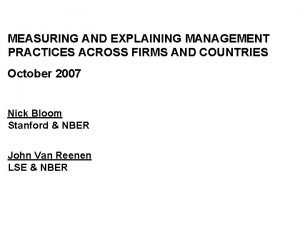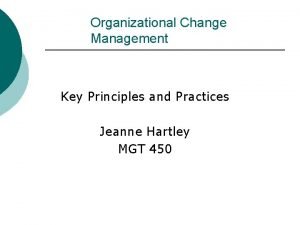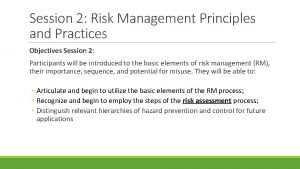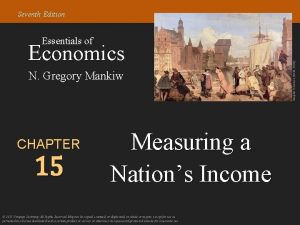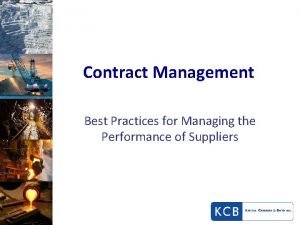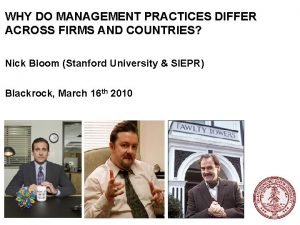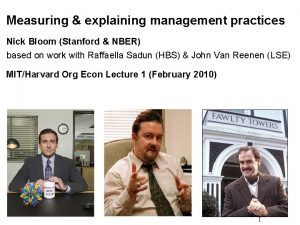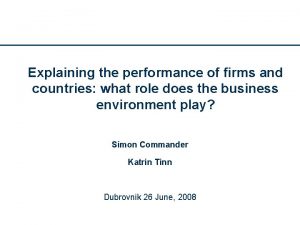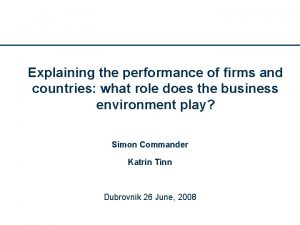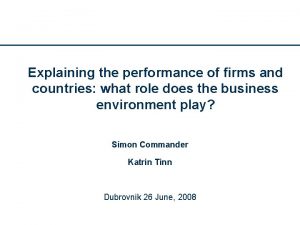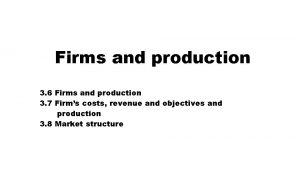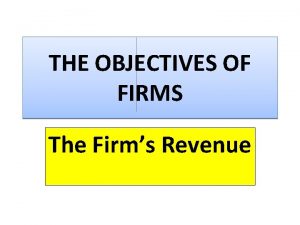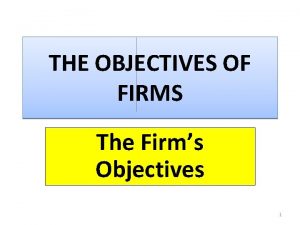MEASURING AND EXPLAINING MANAGEMENT PRACTICES ACROSS FIRMS AND


































- Slides: 34

MEASURING AND EXPLAINING MANAGEMENT PRACTICES ACROSS FIRMS AND COUNTRIES Nick Bloom & John Van Reenen (Centre for Economic Performance, LSE) Very grateful for support and funding from the: Economic and Social Research Council; Advanced Institute of Management; and Anglo German Foundation Slides & paper on my CEP website http: //cep. lse. ac. uk/people/bio. asp? id=1498

MOTIVATION Large persistent productivity differences across firms and countries which people typically claim is due to “management” • But what is the role of management? • And why does it vary so much across firms and countries? To address these questions in 2001 LSE and Mc. Kinsey 1 started an ambitious joint research project to collect the first firm level international management data set. The LSE received no funding from Mc. Kinsey – this was made possible by the generous support of the ESRC, AIM and the AGF! 1

OUTLINE • “Measuring” management practices • Evaluating our management measure • Describing management across firms & countries • Explaining management across firms & countries • Policy implications

NEW APPROACH TO MEASURE MANAGEMENT 1) Develop management practice scoring • Scorecard for monitoring, targets and incentives • 45 minute phone interview of plant managers 2) Obtain unbiased responses • “Double-blind” • Managers are not told they are being scored • Interviewers do not know company performance 3) Get firms to participate in the interview • • • Introduced as “Lean-manufacturing” interview, no financials Endorsed by Bundesbank , UK Treasury & Banque de France Run by 10 MBAs (loud, pushy & business experience)

MONITORING - i. e. “HOW IS PERFORMANCE TRACKED? ” Score (1): Measures tracked do not indicate directly if overall business objectives are being met. Certain processes aren’t tracked at all (3): Most key performance indicators are tracked formally. Tracking is overseen by senior management (5): Performance is continuously tracked and communicated, both formally and informally, to all staff using a range of visual management tools Note: All 18 dimensions and over 50 examples in Bloom & Van. Reenen (2006).

WE SURVEYED MEDIUM SIZED MANUFACTURING FIRMS • US (≈300), UK, France and Germany (≈150 each) • Medium sized manufacturers, typically about 500 employees • Medium sized because firm practices more homogeneous • Manufacturing because easier to measure productivity • Good response rate of 54%, with response uncorrelated with firm performance

OUTLINE • “Measuring” management practices • Evaluating our management measure • Describing management across firms & countries • Explaining management across firms & countries • Policy implications

INTERVAL VALIDATION SUGGESTS MANAGEMENT SCORING PROCESS IS CONSISTENT Re-interviewed 64 firms with different MBA interviewers speaking to different plant managers 2 nd interview Firm average scores (over 18 question) Correlation of 0. 75 suggests interviews pretty reliable 1 st interview

WE ALSO UNDERTOOK EXTERNAL VALIDATION BY COMPARING TO COMPANY ACCOUNTS Labour Productivity 1 Bottom 50% Top 50% Management score Sales Growth, (% pa) Bottom 50% Top 50% Management score Stock Market Value 3 Survival Rates 4, (%) Bottom 50% Top 50% Management score $’ 000 sales per employee at 2000 prices 2 Return on capital employed (%) 1 Profit Rate 2, (%) 3 Tobins’ 4 Q ($ value of firm per $ of assets), quoted firms only (100 - % bankrupt or liquidated 12 months after 2004)

OUTLINE • “Measuring” management practices • Evaluating our management measure • Describing management across firms & countries • Explaining management across firms & countries • Policy implications

FIRM LEVEL MANAGEMENT SCORES BY COUNTRY Germany % of firms France Management score % of firms US % of firms UK Management score

US HIGHEST AND UK LOWEST AVERAGE MANAGEMENT SCORES All firms Firms with management scores above 2 US Germany France UK The long-tail of UK management? • Low UK average score mainly due to the long-tail of badly managed firms

OUTLINE • “Measuring” management practices • Evaluating our management measure • Describing management across firms & countries • Explaining management across firms & countries • Policy implications

COMPETITION AND MANAGEMENT Competition is strongly linked with good management 1 Positive effects of competition appears to be due to two factors • “Selection” – badly managed exit more quickly • “Effort” – competition makes managers try harder Used the standard “domestic” and “import” competition measures in Nickell (1996) and found they were all strongly and positively linked to better management 1

EDUCATION, SKILLS AND MANAGEMENT Educations, skills and training are strongly linked with good management 1 Positive correlation with education appears be a combination of: • Cause: educations & skills facilitates better management • Effect: educated & skilled people attracted to well managed firms Robust link of good management with our five educations and skills proxies: (i) % employees with a degree; (ii) % of employees with an MBA, (iii) training days per year for managers; (iv) training days per year for non-managers; and (v) average wages 1

INHERITED FAMILY FIRMS AND MANAGEMENT Inherited “family” firms defined as 2 nd generation family owned – excludes 1 st generation “founder” firms (typically well run) Quality of management practices in inherited family owned firms depends on who runs them • Firms with professional management typically run well • Firms with inherited family management typically run less well Work from Columbia, Harvard, and NYU shows inherited family management also bad for productivity and growth, particularly in larger firms and faster growing industries In UK inherited family firms typically family managed while in the US and Germany typically professionally managed

A FAMOUS UK INHERITED FAMILY MANAGED FIRM, WITH A BOARD MEETING IN PROGRESS…. Note: Albert Steptoe inherited “Steptoe & Son” from his father, making him the 2 nd generation, and Harold the 3 rd generation

DO THESE FACTORS EXPLAIN THE UK-US MANAGEMENT GAP? UK-US MANAGEMENT PRACTICE GAP 1 Total Competition management Gap Inherited family Education (% employees managed firms (primogeniture) with degree) Residual management gap Note: (a) based on our sample of medium sized manufacturing firms; (b) 1 point on the management scale associated with about 20% higher productivity. 1

OUTLINE • “Measuring” management practices • Evaluating our management measure • Describing management across firms & countries • Explaining management across firms & countries • Policy implications

BACKGROUND TO THE INHERITANCE TAX POLICY IMPLICATIONS Standard assets (savings, housing etc) • 40% inheritance tax above a £ 275, 000 threshold Private companies (typically family firms) • 0% inheritance tax, and no cap on this relief • Exemption introduced in Budgets from 1979 to 1992 • Rationale that inherited family firms help the economy A £ 1 m family firm has 16 employees on average. Taxing firms with >£ 1 m will exclude most family shops, pubs, small businesses etc. 1

POLICY IMPLICATIONS FOR INHERITANCE TAX We find that inherited family management is associated with poorer management and lower productivity among medium and larger firms. Given this, there may be benefits from capping the inheritance tax exemption for private companies: 1 • Increase productivity by removing a distortion in favour of family inheritance in larger firms 1 • Improve intergenerational equality - which is bad in the UK by international standards - by taxing large inheritances • Raise revenue – for example a £ 1 m cap would raise £ 250 m 90% of family firms worth less than £ 1 m. An average £ 1 m firm has 16 employees.

MANAGEMENT RESEARCH NEXT STEPS This summer follow up a second survey wave on 3000 firms to: • • Extend to more countries: • Italy, Poland, Portugal, Sweden and Greece • Pilot in India Extend to more industries • • Pilots in Retail, Education (Schools) and Health (Hospitals) Extend to look at organisational structure and use of IT Quotes to finish……. .

THE WORLD OF MANUFACTURING Spoke to companies making…. . • Plastic balls to stop birds nesting on water near airports (reported no competitors) • European sex-toys (few exports – aimed at domestic “tastes”) …. and an amazing array of people • “I spend most of my time walking around cuddling and encouraging people - my staff tell me that I give great hugs” • [US male manager to an Australian female interviewer] “Your accent is great and I like your talk – are you married? ” • “………. …. . [long silence]…………. sorry I just got distracted by a submarine surfacing in front of my office window”

THE SUMMER 2004 SURVEY TEAM Top: Middle: Manish Mahajan, Johannes Banner, John Van Reenen, Tom Rippin Himanshu Pande, Mehdi Boussebba, Michael Bevan, Simone Martin, Jayesh Patel Bottom: Nick Bloom, Marcus Thielking, Alberic De Solere

SCORECARD COVERS 18 QUESTIONS IN 4 AREAS Developed by leading international consulting firm All questions examples in Bloom and Van. Reenen (2006) OPERATIONS (3) - problem fixing, Lean manufacturing etc. MONITORING (5) - tracking, review & evaluation, follow-up etc. TARGETS (5) - transparent, stretching, linked, time horizon etc INCENTIVES (5) - promotions, rewards, fix/fire, retention etc.

TARGETS – e. g. TARGETS ARE STRETCHING (Q. 11) Score (1) Goals are either too easy or impossible to achieve; managers low-ball estimates to ensure easy goals (3) In most areas, top management pushes for aggressive goals based on solid economic rationale. There a few "sacred cows" not held to the same rigorous standard (5) Goals are genuinely demanding for all divisions. They are grounded in solid, solid economic rational E. G. A chemicals firm has 2 divisions, producing special chemicals for military and civilian markets. Easier levels of targets are requested from the founding and more prestigious military division. A UK manager insists that he sets aggressive and demanding goals for everyone – even security. If they hit all their targets he worries he hasn’t stretched them enough. A French firm uses easy targets to improve staff morale. They find it difficult to set harder goals because people give up and managers refuse to work people harder

INCENTIVES – e. g. PROMOTIONS (Q. 16) Score (1) People are promoted primarily upon the basis of tenure (3) People are (5) We actively identify, promoted upon the develop and promote our basis of top performers performance E. G. People learn on the job and are promoted based on their performance on the job. A UK firm promotes based on an individual’s commitment to the company, typically measured by experience. Almost all employees move up in lock-step. In a UK firm each employee is thoroughly assessed every 6 months and given a red light (not performing), amber light (doing well – on track) a green light (high performer promote) and a blue light (extreme performer - promote twice)

MONITORING - i. e. “HOW IS PERFORMANCE TRACKED? ” Score (1): Measures tracked do not indicate directly if overall business objectives are being met. Certain processes aren’t tracked at all (3): Most key performance indicators are tracked formally. Tracking is overseen by senior management (5): Performance is continuously tracked and communicated, both formally and informally, to all staff using a range of visual management tools E. G. “A US firm barcodes every product, and performance indicators are tracked throughout the production; but this information was not shown to workers” “A US firm had screens visible to every production line with hourly progress to target. The plant manager met daily with the shop floor to discuss these. He even stamped canteen napkins with key performance achievements” “A US manager tracked measures when he thought output was not sufficient. He last requested reports eight months ago, checked them for a week, and then stopped checking once output had increased”

MANY COMPETITORS AND NO (PG) FAMILY CEO N=317 2. 7% firms in tail 1 FEW COMPETITORS AND/OR (PG) FAMILY CEO N=415 9. 0% firms in tail 1 1 Tail defined as a score ≤ 2. In the whole sample 6. 9% of firms are in the tail.

OTHER RESEARCH FINDS SIMILAR NEGATIVE IMPACT OF INHERITED FAMILY MANAGEMENT Three very good recent papers from Harvard, Columbia and NYU: • Villalonga & Amit (2005) look at quoted US firms and find family firms average productivity if professionally managed but low productivity if 2 nd+ generation family managed • Perez-Gonzalez (2006) looks at quoted US firms and find when the founder announces his retirement the share price jumps if next CEO is to be an outsider but drops if it is to be a 2 nd generation family member (particularly one with non-selective college degree) • Bennedsden et al. (2006) look at over 5, 000 Danish firms using the gender of the first born child to identify a negative causal impact of inherited family management on productivity, particularly in larger and faster growing firms.

INHERITED FAMILY FIRMS AND MANAGEMENT We define “inherited family firms” as firms owned by the 2 nd generation or beyond. This excludes 1 st generation “founder” firms, who are typically well managed. %1 UK Fra Ger US Inherited family largest shareholder 30 32 30 10 Inherited family largest shareholder and CEO 23 22 12 7 Inherited family largest shareholder family CEO, chosen by primogeniture 2 15 14 3 3 1 All shareholdings combined across all family members. 2 Based on question: “How was management of the firm passed down: was it to the eldest son or by some other way? ”. Non primo geniture alternatives in frequency order: other sons, son in-laws, daughters, brothers, wives, nephews and cousins.

WHY DOES FAMILY INVOLVEMENT VARY ACROSS COUNTRIES? • One reason is history – US and Germany more of a tradition of professional management versus UK and France tradition of hereditary family management 1. • Another reason is inheritance tax 2: headline rates on a typical large family firm • US ≈ 50% France ≈ 25% • UK = 0% 1 See Germany ≈ 15% Bloom and Van Reenen (2006) for references and details 2 Rate on a private $25 m firm. These taxes are often reduced/avoided by advanced tax planning, although this involves foresight, financial costs and some control loss.

UK PROBLEM OF INHERITED FAMILY FIRMS IS IN FACT AN OLD TOPIC Harvard historians Alfred Chandler and David Landes 1 claimed UK manufacturing decline from the early 1900 s (versus US & Germany) due to inherited family management 2: More recent work from Columbia, Harvard, and NYU also shows inherited family management bad for productivity, profitability and growth, particularly in larger firms and faster growing industries Alfred Chandler (1994), “Scale and Scope: The Dynamics of Industrial Capitalism”, and David Landes (1967) “The Unbound Prometheus”. 2 The phrase “Clogs to clogs in three generations” reflects these inherited management problems. The Chinese have a similar phrase of “Paddy field to paddy field” 1

US FIRMS ARE ALSO BETTER IN EUROPE Average management score by firm type in UK, France and Germany* # in sample Domestic 379 Non-US multinational subsidiary 44 US multinational subsidiary 20 * Controls for any sample selection on size (direct and group) and listing
 Management practices across firms and countries
Management practices across firms and countries Understanding hydroponics
Understanding hydroponics Explaining voltage
Explaining voltage Explaining how something works
Explaining how something works Describing trends in graphs examples
Describing trends in graphs examples A pamphlet explaining how an unborn child
A pamphlet explaining how an unborn child Explaining deviance biological perspect
Explaining deviance biological perspect Templates for introducing quotations
Templates for introducing quotations Complex sentence starters
Complex sentence starters Mowrer two process model
Mowrer two process model Explaining patterns hots
Explaining patterns hots Female genitalia labeled
Female genitalia labeled Saira has a fear of cats
Saira has a fear of cats University of alberta project management
University of alberta project management Project management principles and practices
Project management principles and practices Change management principles and practices
Change management principles and practices Safety practices and sports injury management pictures
Safety practices and sports injury management pictures Risk management principles and practices
Risk management principles and practices Multidomestic strategy
Multidomestic strategy Managing human resources in small and entrepreneurial firms
Managing human resources in small and entrepreneurial firms Employee selection
Employee selection Managing human resources in small and entrepreneurial firms
Managing human resources in small and entrepreneurial firms Households and firms circular flow model
Households and firms circular flow model What are the functions of securities firms
What are the functions of securities firms At the most fundamental level firms generate cash and
At the most fundamental level firms generate cash and Prm vs crm
Prm vs crm Mrp system ppt
Mrp system ppt Security management practices
Security management practices It infrastructure project management best practices
It infrastructure project management best practices Nurseries are seasonal pond
Nurseries are seasonal pond Territory management best practices
Territory management best practices Data quality management best practices
Data quality management best practices Grant management best practices
Grant management best practices Supplier performance management best practices
Supplier performance management best practices Fleet maintenance management system best practices
Fleet maintenance management system best practices
